Effects of Soil Properties and Illumination Intensities on Matric Suction of Vegetated Soil
Abstract
:1. Introduction
2. Materials and Test Methods
2.1. Materials and Apparatus
2.2. Test Design and Methods
2.2.1. Test Design
2.2.2. Test Methods
3. Results and Discussion
3.1. Comparison of Plant Transpiration and Soil Evaporation
3.2. Effects of Illumination Intensities on the Matric Suction of Vegetated Soil
3.3. Effects of Soil Properties on the Matric Suction of Vegetated Soil
4. Conclusions
Author Contributions
Funding
Conflicts of Interest
References
- Ho, K.M.Y.; Ng, C.W.W.; Ho, K.K.S.; Tang, W.H. State-dependent soil-water characteristic curves of weathered soils. In Unsaturated Soils 2006; American Society of Civil Engineers: Reston, VA, USA, 2006; Volume 2, pp. 1302–1313. [Google Scholar]
- Huat, B.B.K.; Ali, F.H.J.; Low, T.H. Water infiltration characteristics of unsaturated soil slope and its effect on suction and stability. Geotech. Geol. Eng. 2006, 24, 1293–1306. [Google Scholar] [CrossRef]
- Lim, T.T.; Rahardjo, H.; Chang, M.F.; Fredlund, D.G. Effect of rainfall on matric suctions in a residual soil slope. Can. Geotech. J. 1996, 33, 618–628. [Google Scholar] [CrossRef]
- Ng, C.W.W.; Menzies, B. Advanced Unsaturated Soil Mechanics and Engineering; Taylor and Francis Press: London, UK, 2007. [Google Scholar]
- Zhan, T.L.T.; Ng, C.W.W.; Fredlund, D.G. Field study of wetting infiltration into a grassed unsaturated expansive soil slope. Can. Geotech. J. 2007, 44, 392–408. [Google Scholar] [CrossRef]
- Watson, A.; Phillips, C.; Marden, M. Root strength, growth, and rates of decay: Root reinforcement changes of two tree species and their contribution to slope stability. Plant Soil 1999, 217, 39–47. [Google Scholar] [CrossRef]
- Genet, M.; Stokes, A.; Fourcaud, T. The influence of plant diversity on slope stability in a moist evergreen deciduous forest. Ecol. Eng. 2010, 36, 265–275. [Google Scholar] [CrossRef]
- Simon, A.; Collison, A.J.C. Quantifying the mechanical and hydrologic effects of riparian vegetation on streambank stability. Earth Surf. Process. Landf. 2002, 27, 527–546. [Google Scholar] [CrossRef]
- Pollen-Bankhead, N.; Simon, A. Hydrologic and hydraulic effects of riparian root networks on streambank stability: Is mechanical root-reinforcement the whole story? Geomorphology 2010, 116, 353–362. [Google Scholar] [CrossRef]
- Leung, A.K.; Ng, C.W.W. Analyses of groundwater flow and plant evapotranspiration in a vegetated soil slope. Can. Geotech. J. 2013, 50, 1204–1218. [Google Scholar] [CrossRef]
- Smethurst, J.A.; Briggs, K.M.; Powrie, W.; Ridley, A.; Butcher, D.J.E. Mechanical and hydrological impacts of tree removal on a clay fill railway embankment. Géotechnique 2015, 65, 869–882. [Google Scholar] [CrossRef]
- Garg, A.; Leung, A.K.; Ng, C.W.W. Comparisons of soil suction induced by evapotranspiration and transpiration of S. heptaphylla. Can. Geotech. J. 2015, 52, 2149–2155. [Google Scholar] [CrossRef]
- Ali, N.; Farshhi, I.; Rees, S.W. Soil-root interaction and effects on slope stability analysis. Electron. J. Geotech. Eng. 2012, 17, 319–328. [Google Scholar]
- Carminati, A.; Vetterlein, D. Plasticity of rhizosphere hydraulic properties as a key for efficient utilization of scarce resources. Ann. Bot. 2012, 112, 277–290. [Google Scholar] [CrossRef] [PubMed]
- Scholl, P.; Leitner, D.; Kammerer, G.; Loiskandl, W.; Kaul, H.P.; Bodner, G. Root induced changes of effective 1D hydraulic properties in a soil column. Plant Soil 2014, 381, 193–213. [Google Scholar] [CrossRef] [PubMed]
- Leung, A.K.; Garg, A.; Ng, C.W.W. Effects of plant roots on soil-water retention and induced suction in vegetated soil. Eng. Geol. 2015, 193, 183–197. [Google Scholar] [CrossRef]
- Ng, C.W.W.; Ni, J.J.; Leung, A.K.; Zhou, C.; Wang, Z.J. Effects of planting density on tree growth and induced soil suction. Géotechnique 2016, 66, 711–724. [Google Scholar] [CrossRef]
- Kirschbaum, M.U.F. Direct and indirect climate change effects on photosynthesis and transpiration. Plant Biol. 2004, 6, 242–253. [Google Scholar] [CrossRef]
- Ng, C.W.W.; Leung, A.K. Measurements of drying and wetting permeability functions using a new stress-controllable soil column. J. Geotech. Geoenviron. Eng. 2012, 138, 58–68. [Google Scholar] [CrossRef]
- Jotisankasa, A.; Sirirattanachat, T. Effects of grass roots on soil-water retention curve and permeability function. Can. Geotech. J. 2017, 54, 1612–1622. [Google Scholar] [CrossRef]
- Veylon, G.; Ghestem, M.; Stokes, A.; Bernard, A. Quantification of mechanical and hydric components of soil reinforcement by plant roots. Can. Geotech. J. 2015, 52, 1839–1849. [Google Scholar] [CrossRef]
- Blight, G.E. The vadose-zone soil-water balance and transpiration rates of vegetation. Géotechnique 2003, 53, 55–64. [Google Scholar] [CrossRef]
- Hemmati, S.; Gatmiri, B.; Cui, Y.J.; Vincent, M. Thermo-hydro-mechanical modelling of soil settlements induced by soil-vegetation-atmosphere interactions. Eng. Geol. 2012, 139, 1–16. [Google Scholar] [CrossRef]
- Ng, C.W.W.; Leung, A.K.; Garg, A.; Woon, K.X.; Chu, L.M.; Hau, B.C.H. Soil suction induced by grass and tree in an atmospheric-controlled plant room. In Proceedings of the 18th International Conference on Soil Mechanics and Geotechnical Engineering, Paris, France, 2–6 September 2013; pp. 1167–1170. [Google Scholar]
- Ng, C.W.W. Atmosphere-plant-soil interactions: Theories and mechanisms. Chin. J. Geotech. Eng. 2017, 39, 1–47. [Google Scholar]
- Ng, C.W.W.; Leung, A.K.; Woon, K.X. Effects of soil density on grass-induced suction distributions in compacted soil subjected to rainfall. Can. Geotech. J. 2014, 51, 311–321. [Google Scholar] [CrossRef]
- Rahardjo, H.; Satyanaga, A.; Leong, E.C.; Santoso, V.A.; Ng, Y.S. Performance of an instrumented slope covered with shrubs and deep-rooted grass. Soils Found 2014, 54, 417–425. [Google Scholar] [CrossRef]
- Kim, J.; Hwang, W.; Kim, Y. Effects of hysteresis on hydro-mechanical behavior of unsaturated soil. Eng. Geol. 2018, 245, 1–9. [Google Scholar] [CrossRef]
- Jeong, S.; Kim, Y.; Park, H.; Kim, J. Effects of rainfall infiltration and hysteresis on the settlement of shallow foundations in unsaturated soil. Environ. Earth Sci. 2018, 77, 494. [Google Scholar] [CrossRef]
- Macneil, D.J.; Steele, D.P.; McMahon, W.; Carder, D.R. Vegetation for Slope Stability-Prepared for Quality Services, Civil Engineering, Highways Agency; TRL Report Press: Berkshire, UK, 2001. [Google Scholar]
- Lin, K.H.; Huang, M.Y.; Huang, W.D.; Hsu, M.H.; Yang, Z.W.; Yang, C.M. The effects of red, blue, and white light-emitting diodes on the growth, development, and edible quality of hydroponically grown lettuce (Lactuca sativa L. var. capitata). Sci. Hortic. 2013, 150, 86–91. [Google Scholar] [CrossRef]
- Sergejeva, D.; Alsina, I.; Duma, M.; Dubova, L.; Augspole, I.; Erdberga, I.; Berzina, K. Evaluation of different lighting sources on the growth and chemical composition of lettuce. Agron. Res. 2018, 16, 892–899. [Google Scholar]
- Foster, S.M. Effect of Aquaponic vs. Hydroponic Nutrient Solution, LED Light Intensity and Photoperiod on Indoor Plant Growth of Butterhead, Romaine and Kale (L. sativa, B. oleracea). Master’s Thesis, California Polytechnic State University, San Luis Obispo, CA, USA, 2018. [Google Scholar]
- Song, W.K.; Cui, Y.J.; Tang, A.M.; Ding, W.Q.; Wang, Q. Experimental study on water evaporation from compacted clay using environmental chamber. Can. Geotech. J. 2016, 53, 1293–1304. [Google Scholar] [CrossRef]
- Ni, J.J.; Ng, C.W.W.; Guo, H.W. Effects of plant characteristics and soil type on transpiration reduction. In Proceedings of the 7th International Conference on Unsaturated Soils, Hongkong, China, 3–5 August 2018. [Google Scholar]
- Mahmood, K.; Kim, J.M.; Ashraf, M. The effect of soil type on matric suction and stability of unsaturated slope under uniform rainfall. KSCE J. Civ. Eng. 2016, 20, 1294–1299. [Google Scholar] [CrossRef]
- Hassan, M.A.; Ismail, M.A.M. Effect of soil types on the development of matric suction and volumetric water content for dike embankment during over topping tests. Civ. Eng. J. 2018, 4, 668–688. [Google Scholar] [CrossRef]
- Indraratna, B.; Fatahi, B.; Khabbaz, H. Numerical analysis of matric suction effects of tree roots. Geotech. Eng. 2006, 159, 77–90. [Google Scholar] [CrossRef]
- Priya, M.I.; Garg, A.; Sreedeep, S.; Sarmah, A.; Daud, N.N.N. Prediction of vegetation-induced soil suction using numerical modelling and AI. In The International Congress on Environmental Geotechnics; Springer: Berlin/Heidelberg, Germany, 2018; pp. 351–358. [Google Scholar]
- ASTM. Standard Practice for Classification of Soils for Engineering Purposes (Unified Soil Classification System); ASTM standard D2487; American Society for Testing and Materials: West Conshohocken, PA, USA, 2010. [Google Scholar]
- Van Genuchten, M. A closed-form equation for predicting the hydraulic conductivity of unsaturated soils. Soil Sci. Soc. Am. J. 1980, 44, 892–898. [Google Scholar] [CrossRef]
- Xu, W.N.; Xia, D.; Zhao, B.Q.; Xia, Z.Y.; Liu, D.X.; Zhou, M.T. Technical Research of Vegetation Restoration in Disturbance Area of Hydropower Project; Science Press: Beijing, China, 2017. [Google Scholar]
- Xia, Z.Y.; Liu, Q.; Xu, W.X.; Rao, Y.K.; Zhang, H. Characteristics of interface friction between Indigofera amblyantha root system and soil. J. Soil Water Conserv. 2018, 32, 128–134. [Google Scholar]
- Gallipoli, D.; Wheeler, S.J.; Karstunen, M. Modelling the variation of degree of saturation in a deformable unsaturated soil. Géotechnique 2003, 53, 105–112. [Google Scholar] [CrossRef]
- Bengough, A.G.; Mullins, C.E. Mechanical impedance to root growth: A review of experimental techniques and root growth responses. Soil Sci. 1990, 41, 341–358. [Google Scholar] [CrossRef]
- Lipiec, J.; Hakansson, I. Influences of degree of compactness and matric water tension on some important plant growth factors. Soil Tillage Res. 2000, 53, 87–94. [Google Scholar] [CrossRef]
- Hu, Y.J. Studies of the Balcony Greening Forms Effects on the Air Temperature and Relative Humidity of Indoor; Donghua University: Shanghai, China, 2010. [Google Scholar]
- Gao, L.J. Study on Water Use Strategy of Populus Euphratica under the Different Moisture Gradient; Xinjiang University: Urumchi, China, 2013. [Google Scholar]
- Gabrm, A.; Akran, M.; Taylor, H.M. Effect of simulated roots on the permeability of silty soil. Geotech. Test. J. 1995, 18, 112–115. [Google Scholar]
- Kong, L.W.; Li, X.M.; Tian, H.N. Effect of fines content on permeability coefficient of sand and its correlation with state parameters. Rock Soil Mech. 2011, 32, 21–26. [Google Scholar]
- Aravena, J.E.; Berli, M.; Ghezzehei, T.A.; Tyler, S.W. Effects of root-induced compaction on rhizosphere hydraulic properties-X-ray microtomography imaging and numerical simulations. Environ. Sci. Technol. 2011, 45, 425–431. [Google Scholar] [CrossRef]
- Romero, E.; Gens, A.; Lloret, A. Water permeability, water retention and microstructure of unsaturated compacted boom clay. Eng. Geol. 1999, 54, 117–127. [Google Scholar] [CrossRef]
- Nuth, M.; Laloui, L. Advances in modelling hysteretic water retention curve in deformable soils. Comput. Geotech. 2008, 35, 835–844. [Google Scholar] [CrossRef]

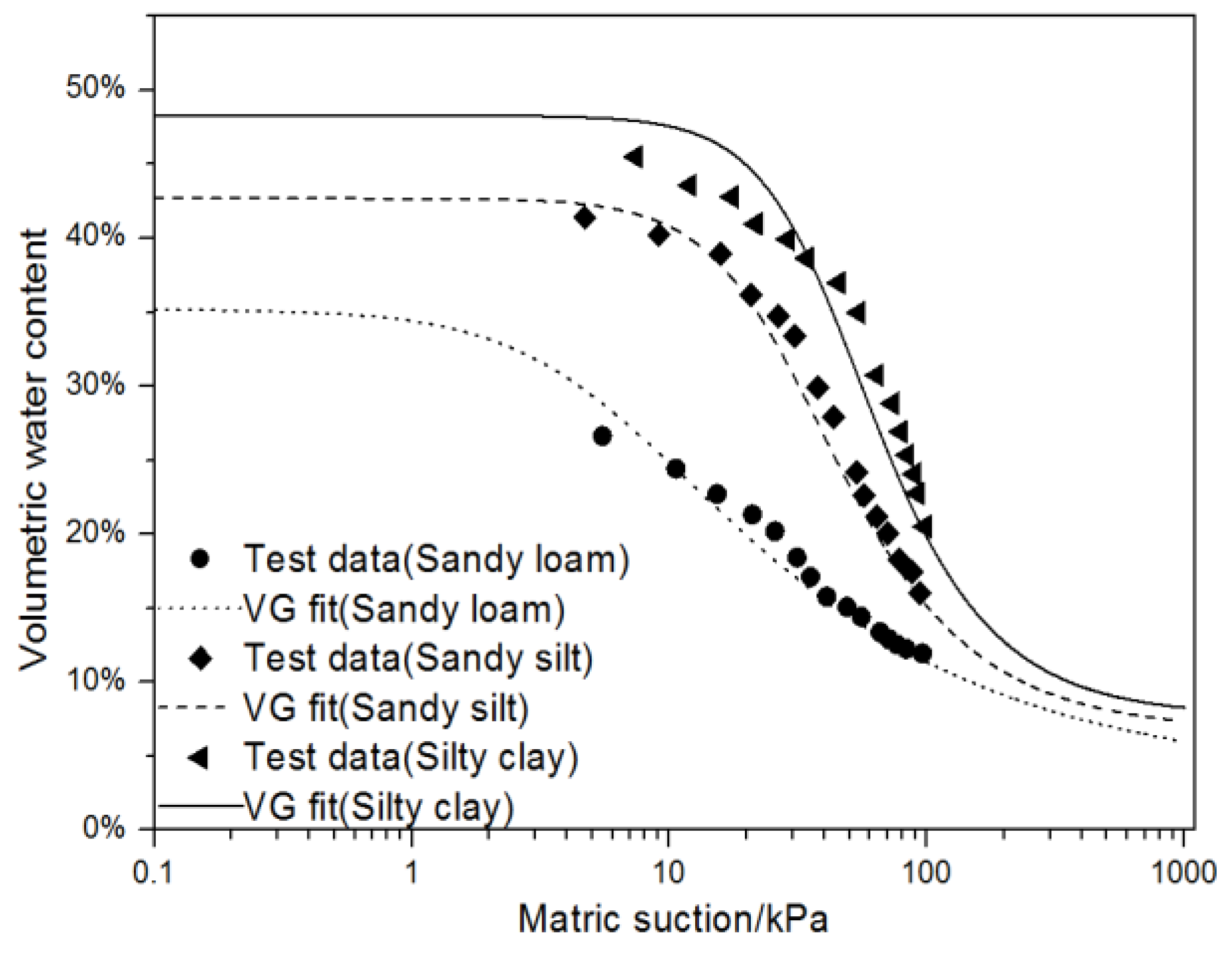
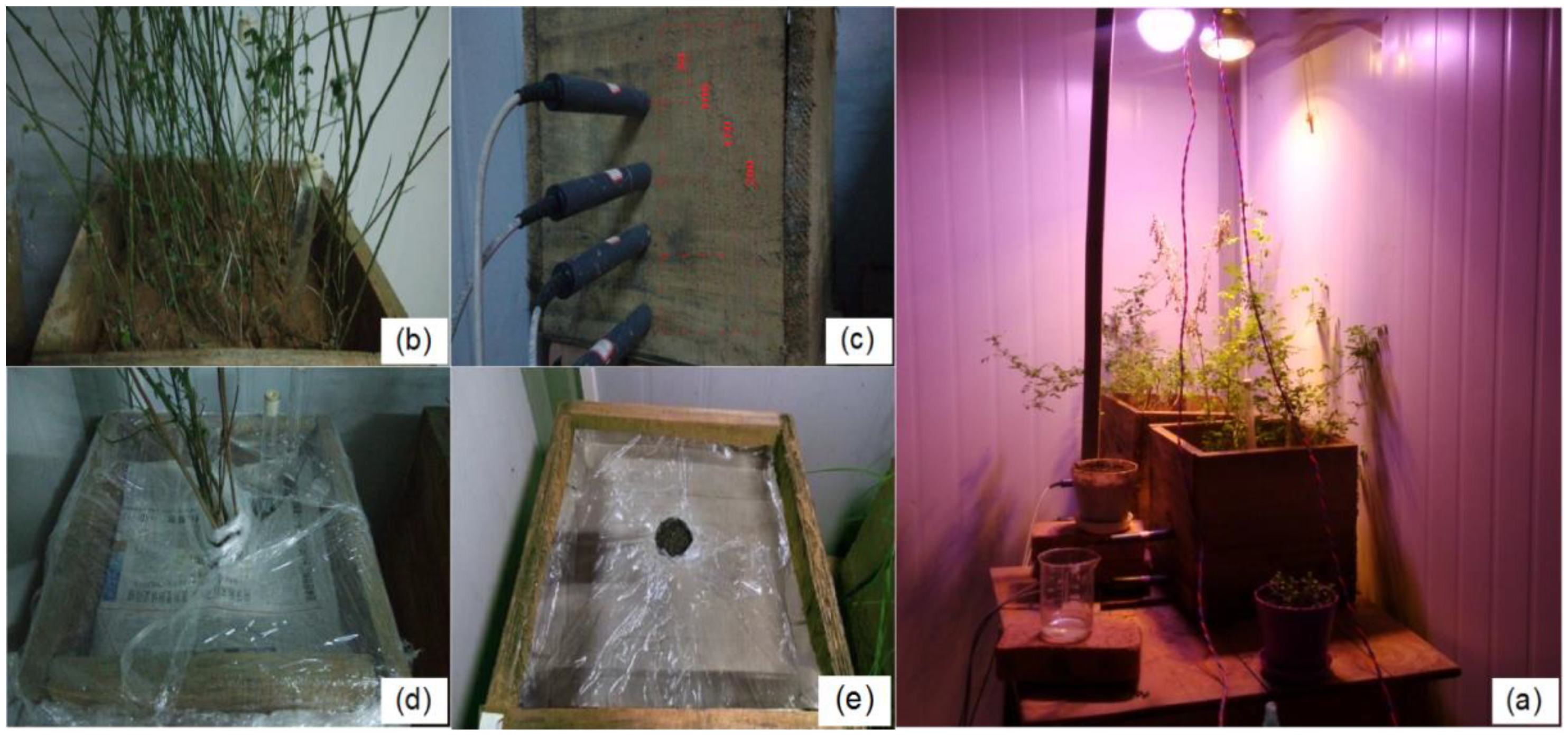
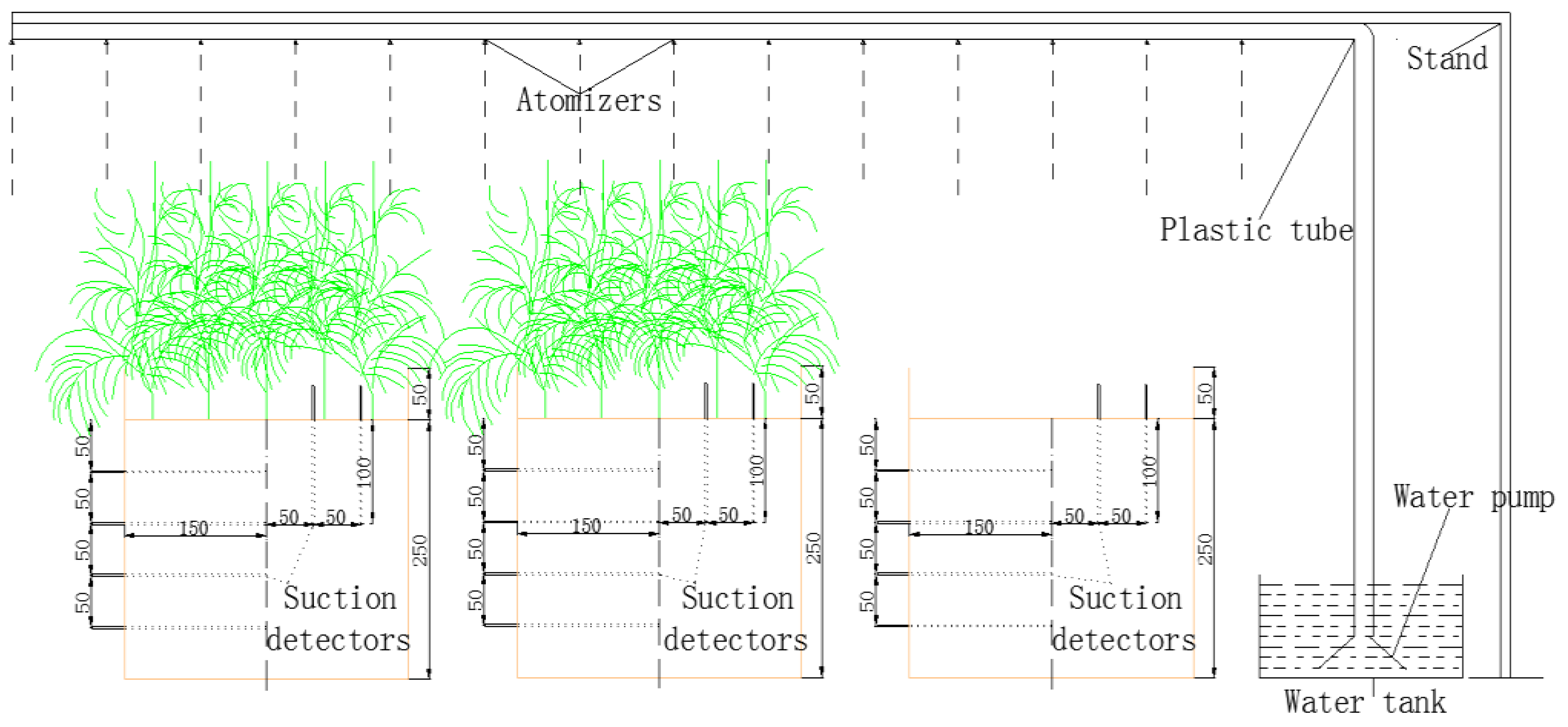
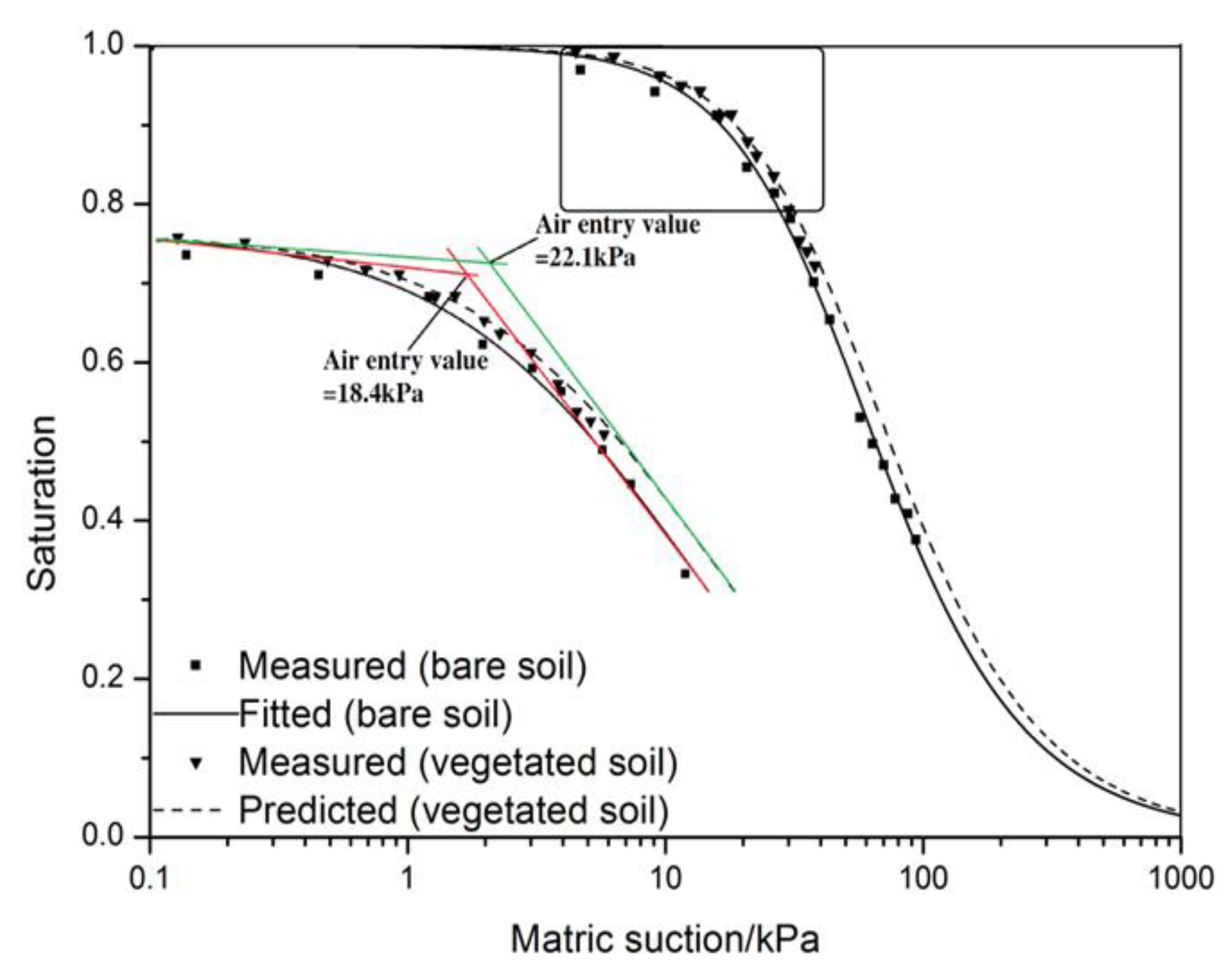
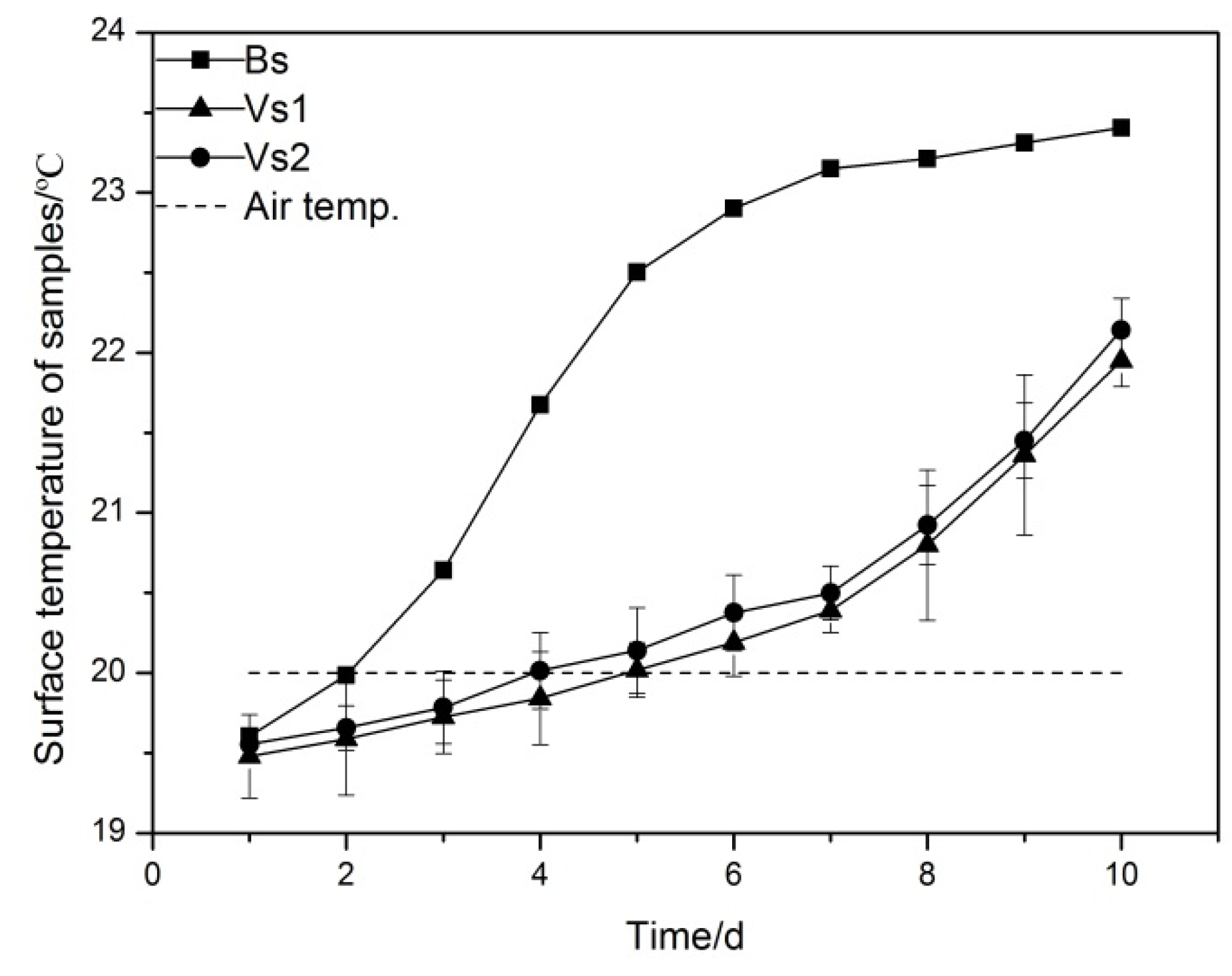
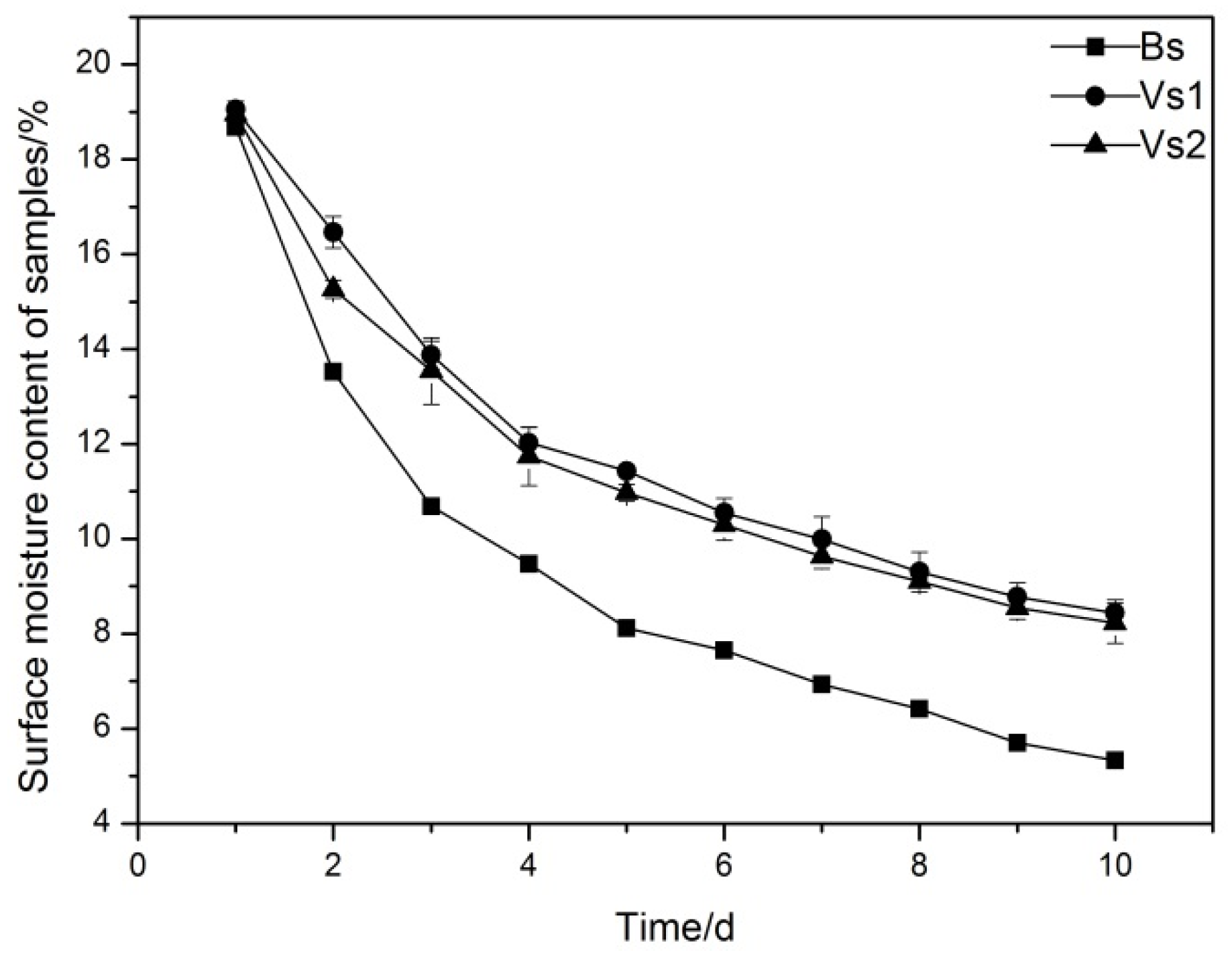
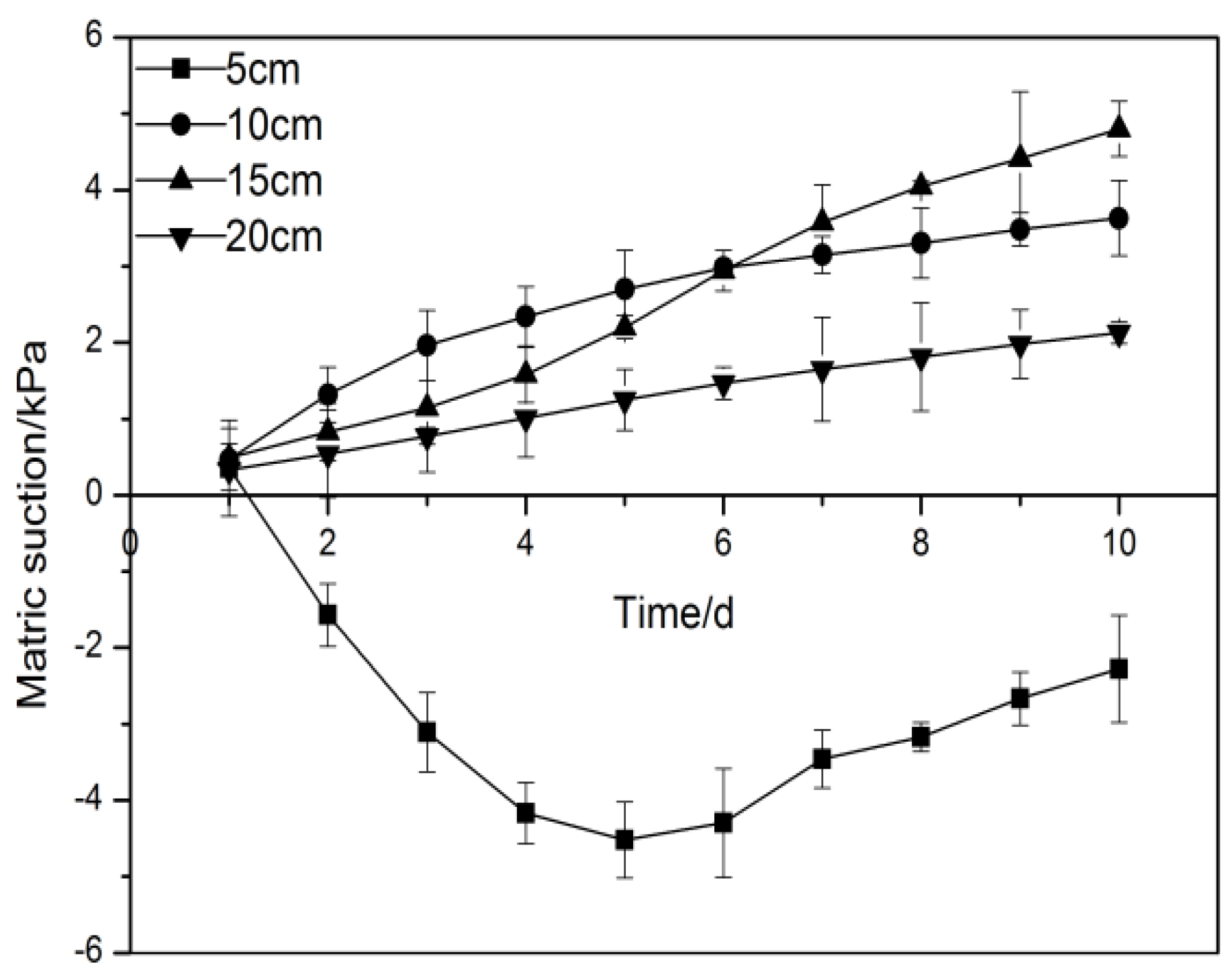
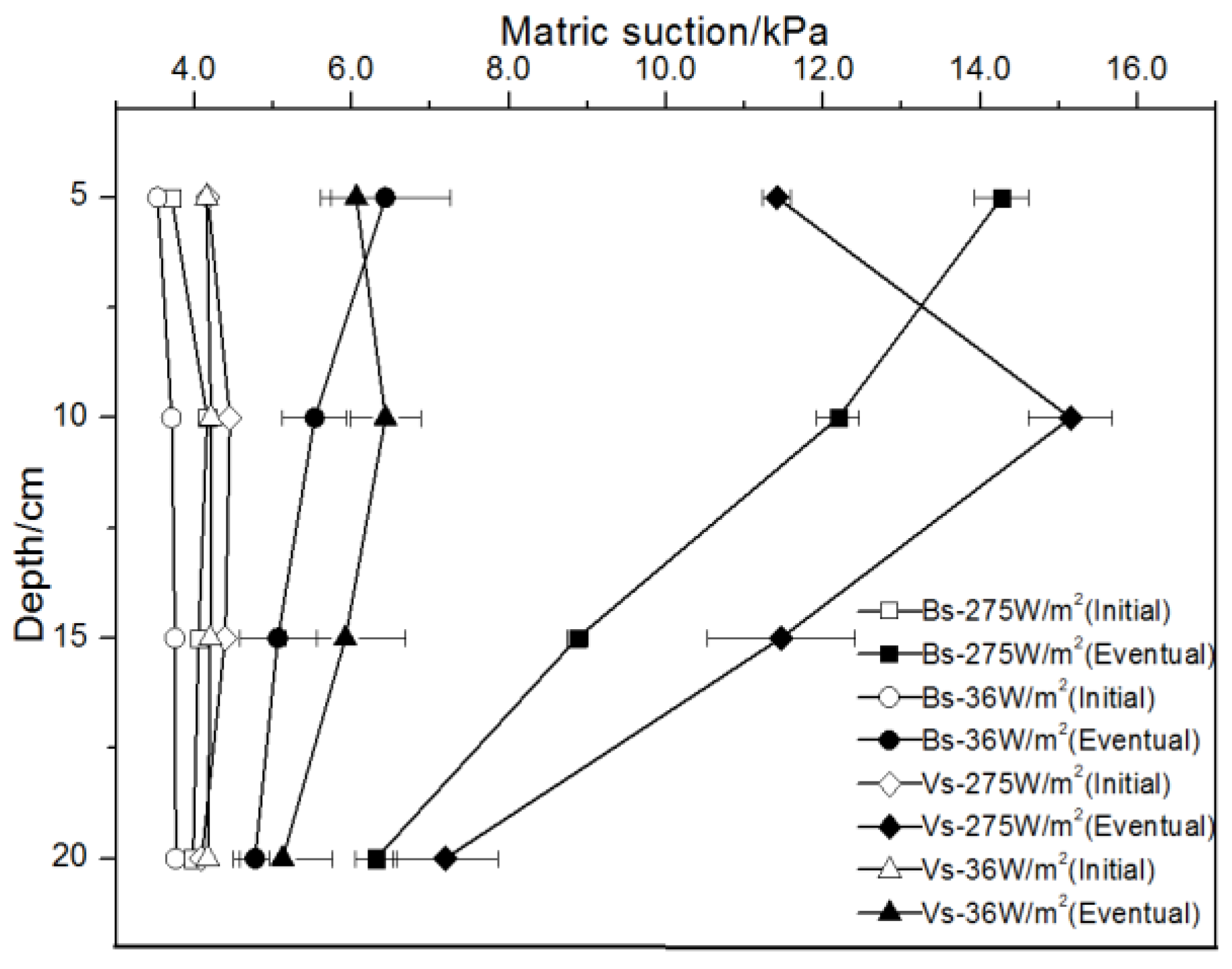
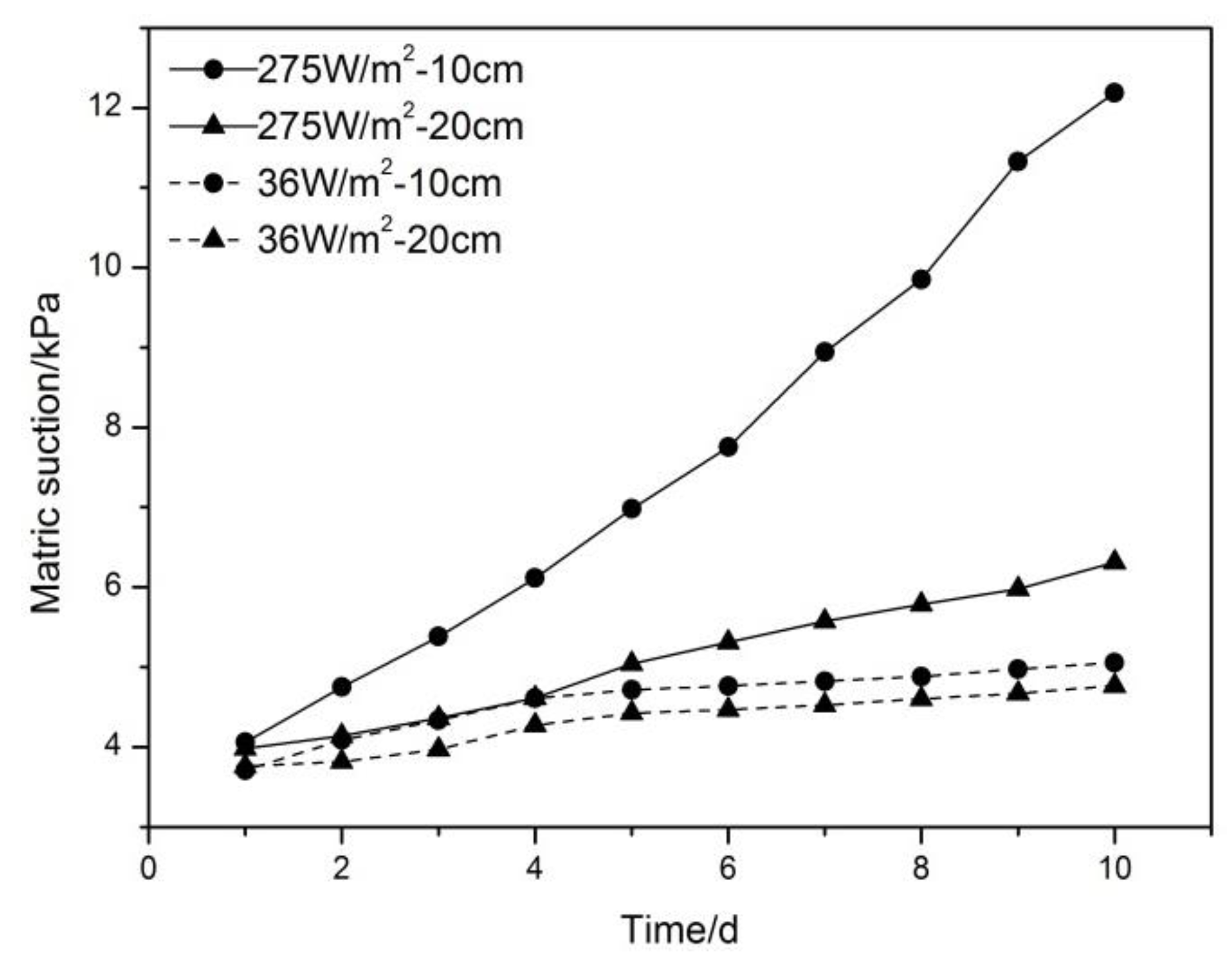
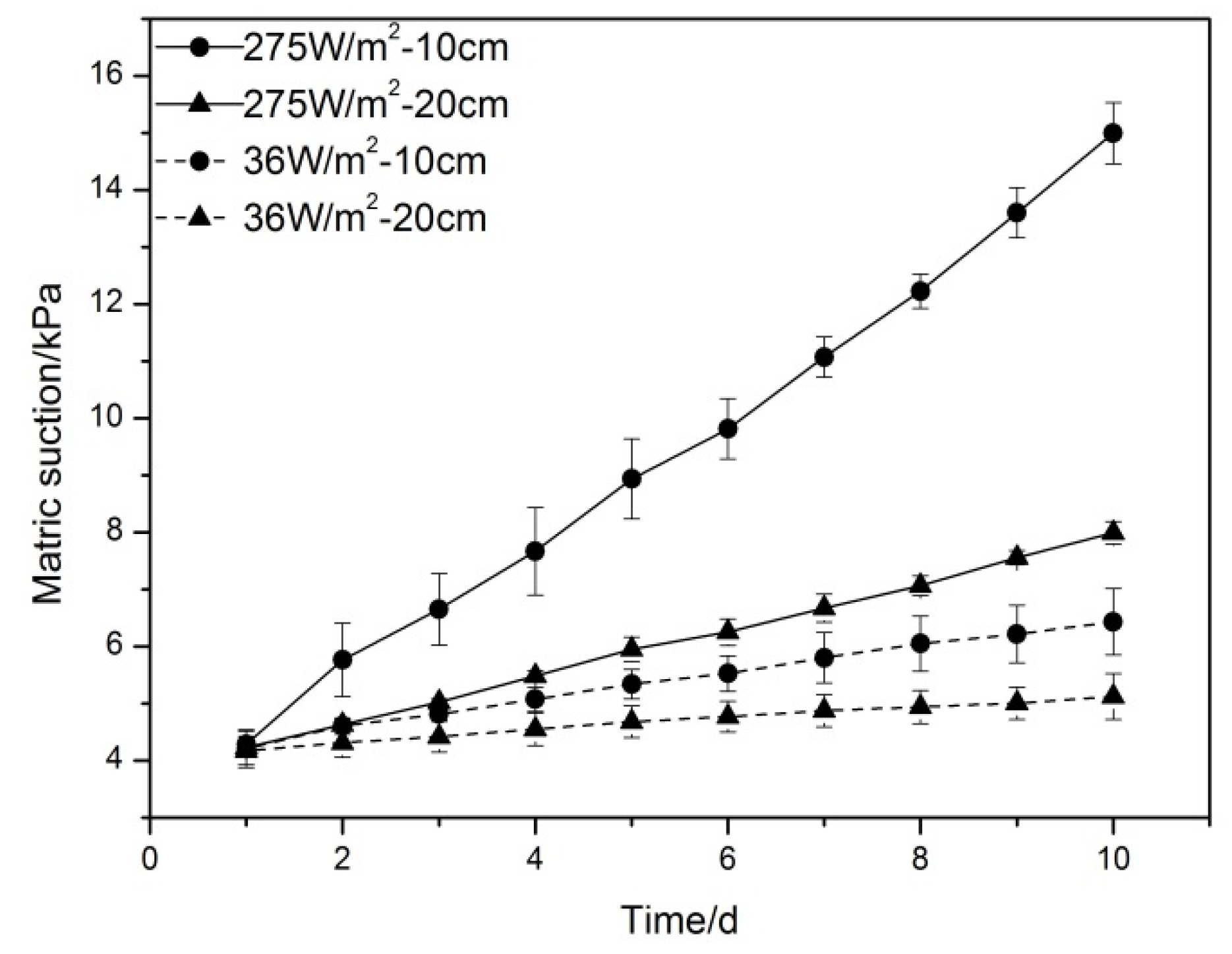
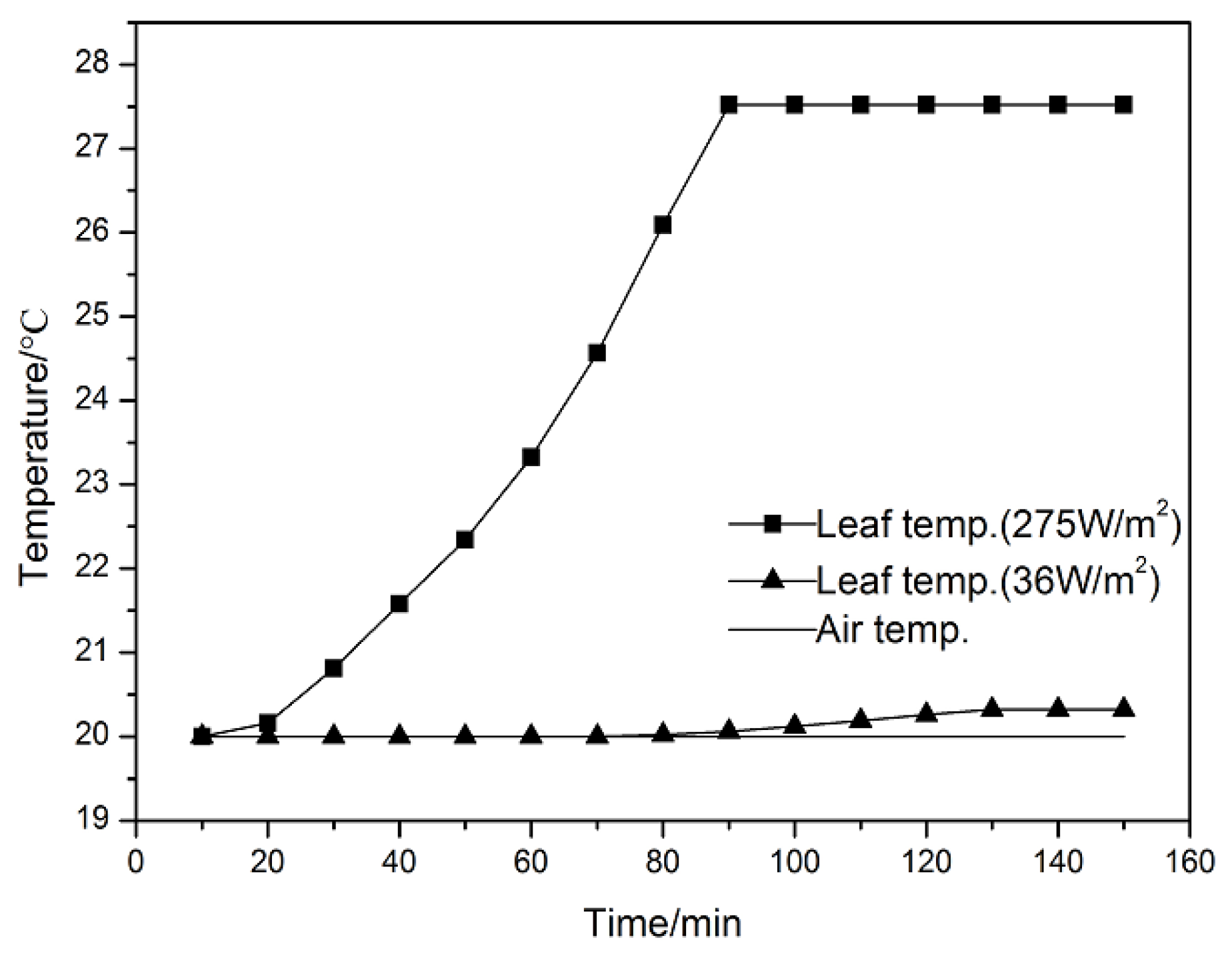

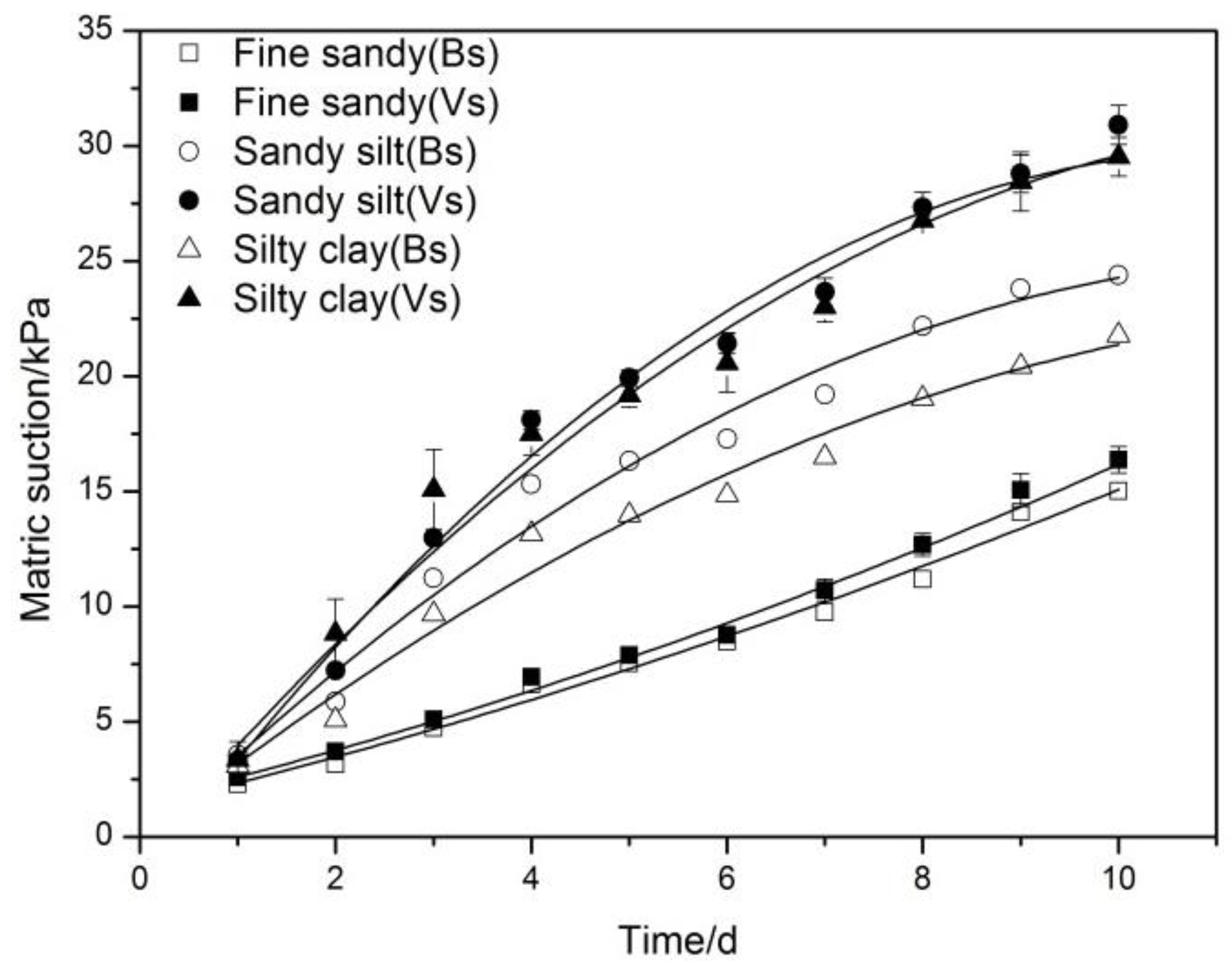

| Soil Types | Specific Gravity | Optimum Moisture Content/% | Maximum Dry Density/% | pH Value | Liquid Limit/% | Plastic Limit/% | Saturated Permeability Coefficient/m·s−1 |
|---|---|---|---|---|---|---|---|
| Fine sandy loam | 2.58 | 14.3 | 1.38 | 6.2 | - | - | 3.23 × 10−5 |
| Sandy silt | 2.69 | 18.6 | 1.61 | 6.5 | 27.5 | 22.5 | 5.75 × 10−6 |
| Silty clay | 2.73 | 19.2 | 1.70 | 6.7 | 30.1 | 18.7 | 2.67 × 10−7 |
| Soil Types | a | n | m | |||
|---|---|---|---|---|---|---|
| Fine sandy loam | 0.032 | 0.352 | 5.47 | 1.469 | 0.319 | 0.935 |
| Sandy silt | 0.065 | 0.427 | 28.4 | 2.125 | 0.529 | 0.924 |
| Silty clay | 0.077 | 0.483 | 43.1 | 2.352 | 0.575 | 0.874 |
| Soil Type | e | Parameters for Equation | ||||
|---|---|---|---|---|---|---|
| Sandy silt | 0.558 | /kPa | ||||
| 0.689 | 1.707 | 7.215 | 3.218 | 0.536 | ||
| Specimen Types | Aerial Biomass/g | Root Biomass/g | Surface Indexes | 1d | 2d | 3d | 4d | 5d | 6d | 7d | 8d | 9d | 10d | P |
|---|---|---|---|---|---|---|---|---|---|---|---|---|---|---|
| Bare soil | - | - | MC (%) | 18.68 | 13.52 | 10.68 | 9.47 | 8.12 | 7.64 | 6.94 | 6.42 | 5.70 | 5.33 | −0.946 |
| Temp. (℃) | 19.6 | 20.0 | 20.6 | 21.7 | 22.5 | 22.9 | 23.1 | 23.2 | 23.3 | 23.4 | ||||
| Vegetated soil 1 | 10.806 + 28.351 | 8.110 | MC (%) | 19.04 | 16.47 | 13.88 | 12.03 | 11.43 | 10.55 | 9.99 | 9.30 | 8.77 | 8.44 | −0.937 |
| Temp. (℃) | 19.5 | 19.6 | 19.7 | 19.8 | 20.0 | 20.2 | 20.4 | 20.8 | 21.4 | 22.0 | ||||
| Vegetated soil 2 | 8.649 + 26.065 | 6.678 | MC (%) | 18.96 | 15.27 | 13.54 | 11.75 | 10.97 | 10.29 | 9.62 | 9.10 | 8.55 | 8.22 | −0.936 |
| Temp. (℃) | 19.6 | 19.7 | 19.8 | 20.0 | 20.1 | 20.4 | 20.5 | 20.9 | 21.5 | 22.1 |
| Specimen Types. | Aerial Biomass/g | Root Biomass/g | Soil Depth/cm | Mean Matric Suction/kPa | |||||||||
|---|---|---|---|---|---|---|---|---|---|---|---|---|---|
| 1d | 2d | 3d | 4d | 5d | 6d | 7d | 8d | 9d | 10d | ||||
| Bare soil | - | - | 5 | 3.87 | 8.41 | 11.71 | 15.42 | 18.46 | 21.37 | 23.57 | 25.25 | 26.48 | 27.32 |
| 10 | 3.82 | 5.21 | 6.50 | 8.29 | 10.85 | 13.90 | 16.50 | 18.42 | 19.92 | 21.53 | |||
| 15 | 3.84 | 4.42 | 5.03 | 5.75 | 6.57 | 7.51 | 8.54 | 9.71 | 11.03 | 13.07 | |||
| 20 | 3.89 | 4.09 | 4.38 | 4.72 | 5.11 | 5.55 | 6.05 | 6.61 | 7.24 | 8.31 | |||
| Vegetated soil 1 | 10.806 + 28.351 | 8.110 | 5 | 4.26 | 7.74 | 9.76 | 12.71 | 15.81 | 19.29 | 22.82 | 25.12 | 26.98 | 28.19 |
| 10 | 4.53 | 6.83 | 9.18 | 11.80 | 14.71 | 18.03 | 20.80 | 22.87 | 24.54 | 26.29 | |||
| 15 | 4.33 | 6.28 | 7.24 | 8.43 | 9.95 | 11.69 | 13.43 | 15.11 | 16.83 | 19.30 | |||
| 20 | 4.22 | 4.63 | 5.15 | 5.72 | 6.36 | 7.02 | 7.70 | 8.42 | 9.22 | 10.45 | |||
| Vegetated soil 2 | 8.649 + 26.065 | 6.678 | 5 | 4.19 | 7.10 | 9.45 | 12.75 | 15.81 | 19.34 | 22.45 | 24.49 | 26.42 | 27.89 |
| 10 | 4.23 | 5.72 | 7.27 | 9.18 | 12.16 | 15.10 | 18.15 | 20.53 | 23.04 | 24.02 | |||
| 15 | 4.33 | 4.95 | 6.38 | 6.70 | 7.51 | 8.92 | 10.58 | 11.58 | 14.41 | 16.43 | |||
| 20 | 4.23 | 4.76 | 4.54 | 5.46 | 5.80 | 6.11 | 7.30 | 8.03 | 8.49 | 9.42 | |||
| Specimen Types | Soil Depth/cm | Aerial Biomass/g | Leaf Area Index | Root Biomass/g | Root Area Index | Root Volume Ratio | Suction 1/kPa | Suction 2/kPa |
|---|---|---|---|---|---|---|---|---|
| Bare soil | 0–10 | - | - | - | - | - | 8.13 | 1.34 |
| 10–20 | - | - | - | 2.33 | 1.01 | |||
| Vegetated soil 1 | 0–10 | 2.263 + 9.706 | 2.397 | 5.186 | 3.543 | 0.03129 | 11.17 | 2.47 |
| 10–20 | 2.924 | 3.128 | 0.02934 | 3.83 | 1.17 | |||
| Vegetated soil 2 | 0–10 | 2.182 + 9.164 | 2.151 | 4.089 | 3.023 | 0.03289 | 10.24 | 1.95 |
| 10–20 | 2.589 | 2.974 | 0.03132 | 3.64 | 0.69 |
| Soil Types. | Specimen Types | Aerial Biomass/g | Root Biomass/g | Mean Matric Suction/kPa | |||||||||
|---|---|---|---|---|---|---|---|---|---|---|---|---|---|
| 1d | 2d | 3d | 4d | 5d | 6d | 7d | 8d | 9d | 10d | ||||
| Fine sandy loam | Bare soil Vegetated soil | - | - | 2.29 | 3.15 | 4.73 | 6.62 | 7.53 | 8.48 | 9.74 | 11.17 | 14.08 | 15.02 |
| 10.278 + 28.889 | 8.861 | 2.57 | 3.70 | 5.09 | 6.94 | 7.89 | 8.76 | 10.71 | 12.68 | 15.06 | 16.37 | ||
| Sandy silt | Bare soil Vegetated soil | - | - | 3.55 | 5.87 | 11.24 | 15.31 | 16.33 | 17.28 | 19.21 | 22.18 | 23.80 | 24.39 |
| 8.649 + 26.065 | 6.678 | 3.31 | 6.22 | 12.98 | 18.10 | 19.92 | 21.43 | 23.66 | 27.32 | 28.79 | 30.91 | ||
| Silty clay | Bare soil Vegetated soil | - | - | 3.08 | 5.07 | 9.67 | 13.16 | 13.96 | 14.84 | 16.50 | 19.04 | 20.43 | 21.79 |
| 8.128 + 24.311 | 6.736 | 3.35 | 8.83 | 15.07 | 17.49 | 19.18 | 20.58 | 23.01 | 26.75 | 28.45 | 29.53 | ||
© 2019 by the authors. Licensee MDPI, Basel, Switzerland. This article is an open access article distributed under the terms and conditions of the Creative Commons Attribution (CC BY) license (http://creativecommons.org/licenses/by/4.0/).
Share and Cite
Liu, Q.; Su, L.; Xia, Z.; Liu, D.; Xu, W.; Xiao, H. Effects of Soil Properties and Illumination Intensities on Matric Suction of Vegetated Soil. Sustainability 2019, 11, 6475. https://doi.org/10.3390/su11226475
Liu Q, Su L, Xia Z, Liu D, Xu W, Xiao H. Effects of Soil Properties and Illumination Intensities on Matric Suction of Vegetated Soil. Sustainability. 2019; 11(22):6475. https://doi.org/10.3390/su11226475
Chicago/Turabian StyleLiu, Qi, Lijun Su, Zhenyao Xia, Daxiang Liu, Wennian Xu, and Hai Xiao. 2019. "Effects of Soil Properties and Illumination Intensities on Matric Suction of Vegetated Soil" Sustainability 11, no. 22: 6475. https://doi.org/10.3390/su11226475
APA StyleLiu, Q., Su, L., Xia, Z., Liu, D., Xu, W., & Xiao, H. (2019). Effects of Soil Properties and Illumination Intensities on Matric Suction of Vegetated Soil. Sustainability, 11(22), 6475. https://doi.org/10.3390/su11226475





